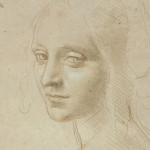By Karen Gonzalez
Wine-dark walls and low light create an atmosphere of a sanctuary where people speak in hushed tones.
WANT TO GO?
The museum is open from 10 a.m. to 5 p.m. on Tuesday and Thursday through Sunday. On Wednesday, the museum is open from 10 a.m. until 9 p.m. Guided tours of the exhibition are scheduled for 1 p.m. on Saturday and Sunday and at 6 p.m. on Wednesday.
Tickets cost $15, though admission is free to members of the museum, children under 12, William & Mary students, faculty and staff.
Colonial Williamsburg also offers a da Vinci package. You can also get a sneak peek of the exhibit with Thomas Jefferson.
The art of Leonardo da Vinci and Michelangelo Buonarotti complement each other beautifully – ironic since the two were bitter rivals.
“Everyone is familiar with the names of these artists,” said Aaron De Groft, director and chief executive officer of the Muscarelle Museum, calling the exhibition a “once in a lifetime” chance for visitors to see drawings from the pair. This collection will be seen in only two U.S. locations—Boston and Williamsburg.
The small size of the drawings is one surprise.
“The drawings are also smaller than our usual experience because the Renaissance small objects are often considered precious,” said John T. Spike, assistant director and chief curator of the Muscarelle Museum.
The exhibit includes more than 25 drawings, the highlight of which is a single drawing of an angel, in a room all to itself.
The “Study for the Head of an Angel for the Madonna of the Rocks,” which renowned art historian Sir Kenneth Clark called “one of the most beautiful drawings in the world.”
This study was composed for the angel in da Vinci’s first painting of the “Virgin of the Rocks.” Its combination of natural form and perfect beauty creates a breathtaking masterpiece.
In stark contrast to the angel drawing, the exhibit also showcases da Vinci’s portrayal of the unlovely.
“At the entrance to the major gallery, there is the contrast to beauty and non-beauty. For that reason we display Leonardo’s quote, “Bello and brutto,” Spike said.
Leonardo da Vinci’s self portrait from Codex on the Flight of Birds has never before been exhibited.
Who, or what, defines perfect beauty?
That is a question that da Vinci spent a lifetime striving to answer. Far from being repulsed by the grotesque, da Vinci was fascinated by it, especially as it contrasted to beauty.
Indeed, Leonardo himself said: “Opposites produce strong contrasts with one another, and all the more so when they are very close together; that is, the ugly next to the beautiful, the big to the small, the old to the young, the strong to the weak.”
An example of this contrast is a remarkable da Vinci drawing named “An Old Man and a Youth in Facing Profile” from the Uffizi museum in Florence, Italy. The young attractive man faces an old man, wrinkled with experience and wisdom. As they stare at each other, one ponders who has the more desirable traits.
“Leonardo’s approach to beauty is the variety in nature. Michelangelo was just the opposite. Leonardo was physically beautiful and Michelangelo was not. Leonardo was good and kind and Michelangelo was misanthropic,” Spike added.
Or as Leonardo himself said, “There are as many kinds of beauty as there are people who possess it.”
The Muscarelle is the first museum to display the exhibit in the United States, which runs through April 5. After that, the exhibit will be transported to the Museum of Fine Arts in Boston, where it will be displayed from April 15 to June 14. Then the drawings will be returned to the three museums which lent them for this exhibit: the Uffizi, the Biblioteca Reale and the Casa Buonarroti — all in Italy.
Longtime personal relationships with Italian colleagues and the demonstrated scholarship of the Muscarelle Museum’s publications, helped bring the drawings to the College of William & Mary museum.
“The Muscarelle has renewed its place in the national and international spotlight with the announcement of Leonardo da Vinci and the Idea of Beauty,” De Groft said. “This really is a once-in-a-lifetime opportunity because there is nowhere else in the world where one can go and see 30 drawings by the great Leonardo – and to then be able to view contrasting drawings by Michelangelo with which to compare – is simply impossible,” he added.


Leave a Reply